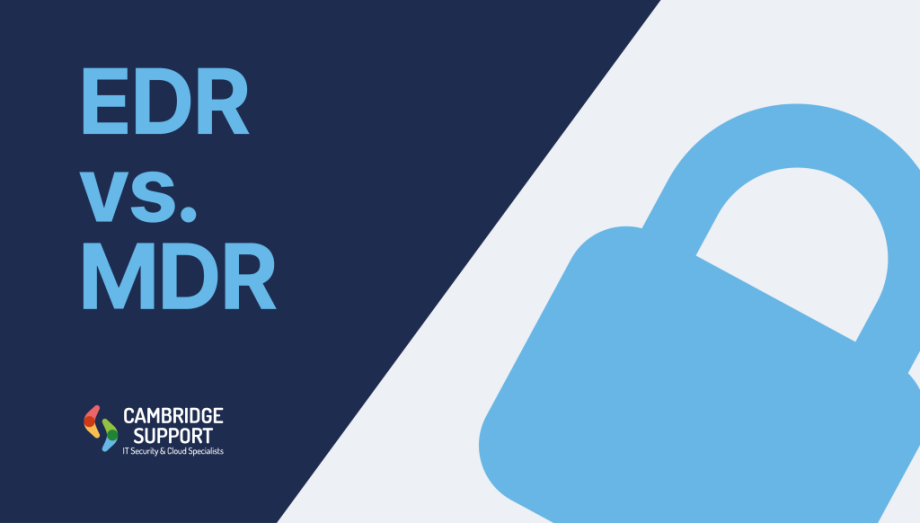Endpoint Detection and Response (EDR) and Managed Detection and Response (MDR) are advanced security solutions that help modern businesses to protect themselves from cyber threats. According to the Cyber Security Breaches Survey 2024, half of UK businesses and around a third of charities report have experienced some form of cyber security breach or attack in the last 12 months. Therefore, it is crucial to be proactive and stay ahead of these evolving threats. This article explores the differences between EDR and MDR and compares how they work.
What is EDR?
Endpoint Detection and Response (EDR) is a category of cybersecurity solutions designed to detect and respond to advanced threats and attacks targeting devices such as laptops, desktops, servers, and mobile devices.
“Endpoint Detection and Response (EDR), also known as Endpoint Threat Detection and Response (ETDR), is an integrated endpoint security solution that combines real-time continuous monitoring and collection of endpoint data with rules-based automated response and analysis capabilities.”
EDR continuously monitors end-user devices to identify and mitigate cyber threats. This continuous surveillance is key to protecting the endpoints within an organisations network.
EDR solutions must provide the following four primary capabilities:
- Detect security incidents
- Contain the incident at the endpoint
- Investigate security incidents
- Provide remediation guidance
How Does EDR Work?
Human responses to cyber attacks can often be too slow to protect IT systems effectively. Without the right tools and processes, it can take hours, days, or even weeks to realise your system has been compromised. The right system and processes need to be in place to contain threats effectively. EDR solutions are designed to address this challenge by providing continuous, real-time monitoring of all endpoints within an organisation.
EDR solutions proactively monitors your endpoints for potential threats. Once a threat is detected, the EDR system can automatically respond by isolating the affected endpoint, stopping threats, and alerting security teams. This quick response is important to minimise the impact of cyber attacks.
EDR typically utilises Artificial Intelligence to detect threats based on the behaviour that a malicious application exhibits. This level of analysis and detection is what sets it apart from traditional definitions-based antiviruses that require knowledge of a malicious app before it identifies and quarantines it. The fact that EDR can protect against zero-day attacks without any prior knowledge of the application simply by assessing behavioural characteristics with AI backing is what makes it such a formidable tool.
The Importance of EDR
The increasing sophistication of cyber threats makes EDR an important part of any organisation’s cyber security. Cambridge Support provides managed EDR solutions to protect your business. Through continually managing and monitoring your endpoints, we give you full visibility of your whole IT environment, detect incidents, investigate alerts, and minimise risks, with transparent regular reporting. For more information, contact us today.
What is MDR?
Managed Detection and Response (MDR) goes beyond individual endpoints to cover the whole IT environment, providing threat detection, response, and mitigation. It integrates advanced monitoring, analytics, and expert intervention to protect your network.
MDR builds on EDR by aggregating security data from many locations, EDR platforms included. It’s able to use this data to hunt for potential threats across the infrastructure. MDR also provides extensive reporting which helps to determine if existing security configurations are working or if there is room to tighten controls.
EDR & MDR
Both EDR and MDR solutions offer improved visibility and security to businesses. However, the two solutions do different things.
EDR is the protection measure on an endpoint; MDR aggregates data from multiple sources to have a wider view of potential threats in an environment. EDR platforms will feed data into an MDR product, as well as things like Entra or on-premises firewalls so all security events are recorded in a centralised console that can be handled by a SOC.
Choosing between the two depends on the needs and resources of your business. If you need a targeted solution for endpoint security, EDR might be the right choice. However, if you require comprehensive security monitoring across your entire IT environment, MDR could be more suitable.
About Cambridge Support
Cambridge Support offers a range of cyber security services, including managed EDR and MDR solutions. Our teams are highly qualified with decades of experience working with small and medium sized businesses. Contact us today to safeguard your business against evolving cyber threats.


